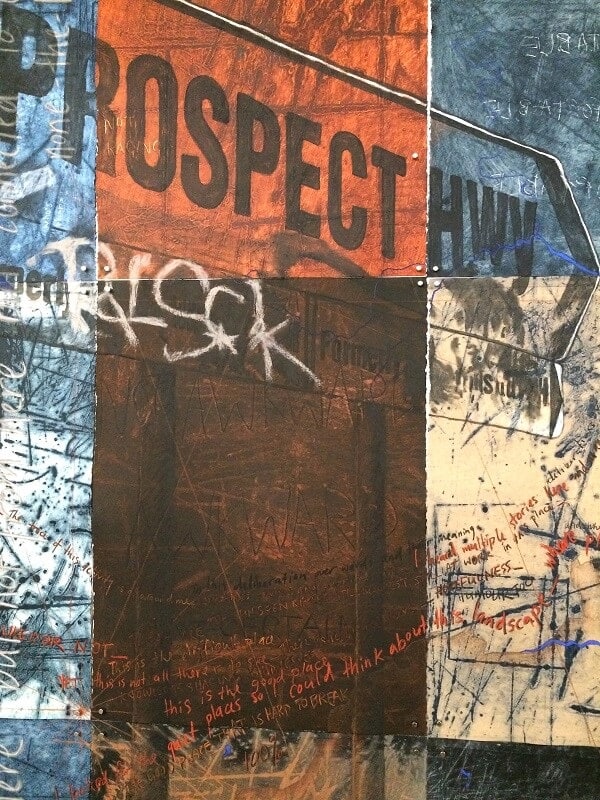This year marks the 250th anniversary of James Cook’s arrival in Australia and the uprising of the Black Lives Matter movement, in the midst of the global Covid-19 pandemic. The alignment of these significant events are cause to reflect more honestly on the wrongs of the past, to acknowledge historical truths in the present, and work towards a better vision for the future.
The Leo Kelly Blacktown Arts Centre in Sydney’s western suburbs has been working with a group of First Nations and culturally diverse artists on the development of a two-part exhibition series ‘Terra inFirma’, which draws on personal and shared stories of history, heritage and identity while exploring the consequences of colonisation on First Nations Peoples and communities from the Asia Pacific region, who live in the Blacktown area.

The first exhibition ‘Terra inFirma’ ran from March to July and featured a range of artworks by artists Kristone Capistrano, Jumaadi, Shivanjani Lal, Venessa Possum, Teivao Pupu Tamariki, Judy Watson and Fozia Zahid, presenting Cook’s landing as an act of transgression, a violation. You can explore this show by virtual tour here.
The second exhibition ‘Terra inFirma: Sovereignty and Memory’ is on view at the Blacktown Arts Centre now until 3 November. Artists Alex Byrne, Gary Carsley, Leanne Tobin and students from Chifley College Bidwell Campus, Dean Cross, Brian Fuata, Jasmine Guffond, Julie Vulcan, Jumaadi and Judy Watson, reflect on the complexities of Country and the landscape with a powerful display of painting, drawing, installation and performance.
At the opening of the exhibition, Dharug artist and cultural consultant Leanne Tobin expressed the importance of understanding the concepts of land and Country. Tobin explained that no matter what is built on top of the land “the road you lay down, the buildings you build, the shoes on our feet. The story is still there. The rivers and creeks running through this place, they still retain and hold those stories of Country from the past.”
Julie Vulcan’s DARKpassage invites audiences into the first gallery space. Vulcan’s installation of abstract forms made using recycled PVC seek to visualise the invisible layers of place that vibrate across time. Inspired by smooth-bark gums aglow in the moonlight, Vulcan’s water-like long form droplets drift in almost unseen motion while soft sounds echo histories within the space. The work is a reminder “that this was once a richly inhabited woodland co-inhabited and cared for,” notes the artist.
In the adjoining gallery an entire wall showcases a large-scale collaborative work created by artists Gary Carsley and Leanne Tobin together with a group of Aboriginal and non-Aboriginal students from Chifley College Bidwell Campus. The artwork titled Sight Cite Site (2020) articulates the shared narrative of dispossession in Australia and the Philippines.
Sight Cite Site was created using substrate black and white photocopy on various tinted A4 papers, with an overlay of colour photocopy on office paper. In Carsley’s words it is a “very patiently applied image” not a wallpaper. His intention he says was to “produce an image to be a stage for multiple voices to speak at once.” With this vision in mind, Carsley designed a layered visual storyboard where the physical identity of the landscape and the histories absorbed by it would synergise in a backwards and forwards motion as a way to reveal the depth of the stories being told.

Moving through the gallery, Blacktown artist Alex Byrne’s series of drawings form large quilt-like artworks, which reflect on 250 years of colonisation from a non-First Nations Australian’s perspective. Jasmine Guffond collaborated with Leanne Tobin and Julie Bukari Webb to construct maps that decolonise the Blacktown area and use Darug language to name and describe local waterways.
Judy Watson references cultural memory in the land and uncovers hidden histories of the Indigenous experience with her work titled leaking shield (2017) created from a found piece of hessian. Dean Cross’ installation FOLLY (2020) features a camp chair, vintage ceramic ashtray, cigarettes, used matches, a Parkes NSW RSL members medallion, Holden car key, white wine and glass, lipstick and a framed commemorative Redheads matchbox featuring James Cook’s Cottage. As part of this work Cross invited First Nations artists, architects and builders to construct a version of the cottage, which was later burnt to the ground as effigy, offering and proclamation.
With a date still to be confirmed for October Brian Fuata will be on site to perform A Sheet a sail at the Blacktown Art Centre, where audiences will observe the artist either haunting, or on the flipside, being possessed by the practices and artworks of other artists in the exhibition.
Jumaadi’s newly commissioned performance Sea of Thorny Fruits will be presented at the Arts Centre on Saturday 31 October at 3pm and 6pm. Here Jumaadi combines the art of ancient shadow puppetry, live music, satire and humour to tell stories of sea transportation throughout history.
At the heart of this year-long project is the knowledge that the land on which we stand was never ceded, nor will it ever be. ‘Terra inFirma’ uncovers historical truths and calls for deeper levels of understanding and more sincere acknowledgement of Aboriginal culture, land and Country. “You can’t reconcile until you’ve actually acknowledged what’s happened,” says Tobin.
“Our peoples continue to show strength, resistance, unity and pride in our culture and Country.” – from the artists statement ‘Terra inFirma: Sovereignty and Memory’, 2020.
Visit Blacktown Arts Centre’s website for more information and bookings on all performance presentations.